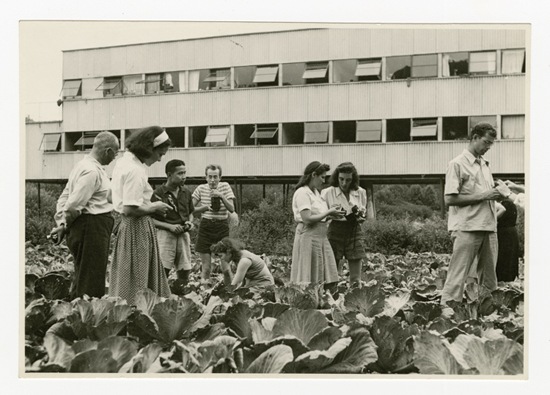Leap Before You Look: Black Mountain College 1933-57
Institute of Contemporary Arts, Boston, USA
Institute of Contemporary Arts, Boston, USA

What was Black Mountain College? This straightforward question is the starting point for ‘Leap Before You Look: Black Mountain College, 1933–57’ organized by Helen Molesworth with Ruth Erickson. The name of this short-lived liberal-arts college in rural North Carolina – it was not an art school, though its founder, John Rice, thought art ‘should be at the very centre of things’ – immediately evokes a hazy mythos, primarily for its associations with Anni and Josef Albers, Elaine and Willem de Kooning, the trio of John Cage, Merce Cunningham and Robert Rauschenberg and the poets Charles Olson and Robert Creeley. Yet how did these seemingly disparate figures all wind up as emblematic of a single institution? How to understand Black Mountain College – and what to think about it now, in relationship to our own institutions – turns out to be a rich, complex question.
‘Leap Before You Look’ begins with a timeline and introduction explaining that Rice wanted to establish a school in the progressive vein of John Dewey, whose maxim was ‘learning by doing’ and who believed that well trained, free-thinking citizens would strengthen democracy. Archival photographs set the scene, showing political-science lectures and biology classes, Saturday night dances, the communal dining halls, and its work-study programme – where students and faculty alike cleaned, cooked and farmed – all while the Great Depression and World War II were unfolding.
From there, the curators chart a roughly chronological course beginning with the hiring – direct from Berlin – of the Alberses, who brought their self-critical models of pedagogy from the shuttered Bauhaus to the Blue Ridge Mountains. Particularly memorable are Anni Albers’s knot drawings, gouaches and tapestries, and jewellery made from corks, hairpins, strainers and paperclips, which spoke to the general material scarcity of the era, as well as the small, fascinating digression about the influence of the Albers’ trips to Mexico. A wall of assignments from Josef’s colour studies class leads into textile samples, student drawings and slides of the matière studies that pupils developed from found materials (leaves, rocks, caterpillar nests, egg whites), collectively establishing Black Mountain College’s resourceful, energetic spirit. Perhaps even more impressive was the design-and-build programme. When the college relocated to the shores of Lake Eden in 1940–41, students and faculty constructed the entire campus themselves.

The show highlights the now-famous figures who congregated in Appalachia and Black Mountain College’s rural cosmopolitanism. Most famously, in 1948, Cage, Cunningham, Buckminster Fuller and the De Koonings were there together, with Ruth Asawa, Ray Johnson and Kenneth Noland among the students. Photographs chart Fuller’s travails that summer, when he tried to create a huge outdoor dome from venetian blinds, which failed – earning it the nickname ‘the supine dome’ – before he realized versions in sturdier materials the following year.
At the show’s mid-point, as the historical personages add up, the curatorial instinct for broad strokes and visual pairings takes over. The forms in Willem and Elaine de Kooning’s remarkably similar-looking paintings from the summer of 1948 are echoed in Leo Amino’s mantis-like resin sculpture Carnivorous Plant #22 (1952). As part of a section about music and Cage’s impact, a piano is paired with a nearby loom, suggesting their analogous manners of operation. Asawa’s hanging sculpture Untitled (S.272) (c. 1955) was placed in front of Rauschenberg and Susan Weil’s body-sized, exposed blue-print Female Figure (c.1950). The final section, following the Albers’ (unexplained) departure in 1949 and the appointment of the poet Charles Olson in 1950, focuses primarily on the pottery programme established by Robert Turner and the eponymous poetry journal that is arguably the school’s most cohesive legacy, before things suddenly collapsed in 1957 due to lack of funding.

That these fatal conditions are vaguely referred to as ‘a lack of funds, a changing set of historical conditions and a variety of internal power struggles’ – between whom is not stated – brings the exhibition to an abrupt conclusion, revealing that, at least in the galleries, ‘Leap Before You Look’ is remarkably unburdened by historical information, biographies and commentary. That material is reserved for the spectacular catalogue, which details the specific experiences of the many figures and their legacies, as well as pressing but unaddressed topics like the role of women at the college and the integration of African-Americans on campus.
In the spirit of Black Mountain College, the best way to experience ‘Leap Before You Look’ is on the ‘extraoptical’ level, as Molesworth calls it, as she’s explaining the college’s ‘haptic’ modes of intertwining of visuality and tactility, criticality and experimentation, and prevailing non-hierarchical, interdisciplinary attitudes. The rendition of Cage’s Sonatas and Interludes (1946–48) played by Elaine Rombola on the piano ‘prepared’ with screws, erasers and paper clips, as a solo performance by Silas Riener of Cunningham’s rediscovered dance Changeling (1957) all take place within the gallery itself. It becomes hard not to be wistful for that time – particularly in comparison to what passes for progressive cultural and institutional values today. Black Mountain College was a haven from fascism, a radical pedagogical experiment, a liberal arts college gone wild, a democracy-building institution, a springboard for countless artistic movements and a crossroads for mid-century avant-gardes. Today, it is a reminder that something else is still entirely possible.
























